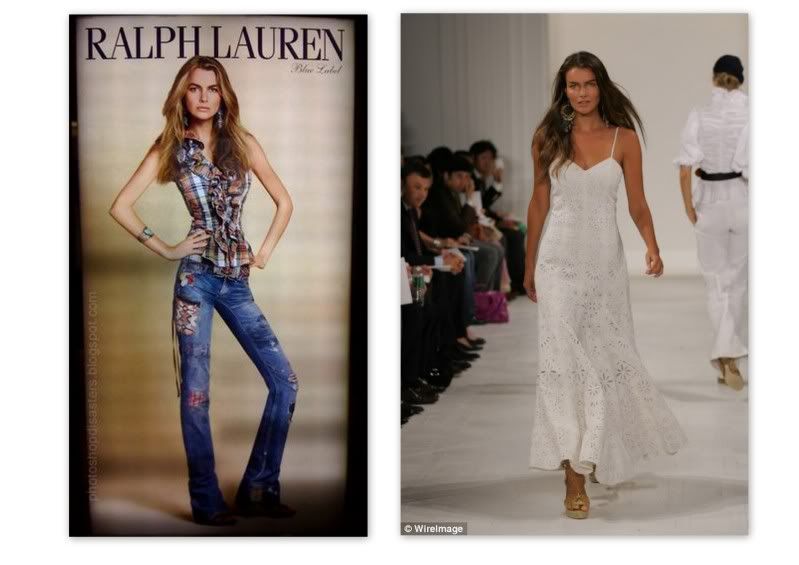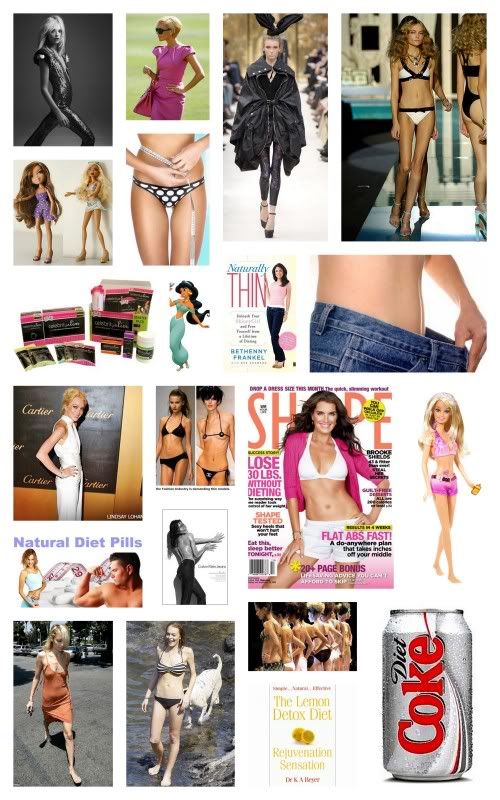The media presents images of people that don’t represent reality. The majority of women in advertisement material, fashion magazines and TV personalities have an unbelievably thin figure. If these women do not posses it through irregular and unnatural eating habits and diets (which is cause for concern especially in the fashion industry), major companies use photo shopping techniques to make it look as though they do. These messages and images shape girls negative attitudes of body image when they do not look as these woman do, causing low self esteem, which trigger their own dieting obsessions that can then lead to eating disorders. Some companies do aspire to promote their company by using ‘real woman’ but the large majority do not, in fact they promote the anorexic look. For a company to sell more products they use images conveying conventional beauty, which in the past decade has become extremely thin. The body types of the women in these images become goals for young women to aspire to, in order to be considered attractive.

The appearance of waif-like models in magazines, on the runways and in advertisement is only a small way in which young woman are constantly bombarded with thinness depicting media on a daily bases. The products in supermarkets which are ‘diet’ or ‘99% fate free’ the advertisement of diet products, plans shakes and pills, weight loss tv shows, actors in films (where the leading/successful role is slim and attractive) gossip columns where celebrities who have put on weight are dissed and those who have lost it are praised. The media is imposing unnatural standards of beauty on women during important developmental stages of their lives. To anyone living in western society, it is inescapable, it fills our daily lives until for some, it becomes an obsession. If messages like this throughout adolescence and woman hood isn’t enough, it is apparent that such messages are embedded in our minds from a young and tender age.
Bundoora’s (1977) social learning paradigm theorizes that the more attractive an observer finds a social agent, the more the observer will strive to try to be like that agent. Children’s films like that of Disney which present the ‘good’ characters as slim and beautiful and the ‘evil’ characters as fat and ugly, toys such as the Barbie doll who is presented as a role model who’s appearance becomes a prototype to children, set shape children’s attitude about what are desirable physical qualities. They are conditioned to idolize and have preference to the media stereotypes.
Studies such as that from the BJHP (2003) conclude young girls have a desire for thinness from as young as 6 years old. The NIMF (1996) found a positive association with movie and television watching and a desire to be thin. Onset of anorexia is generally in adolescence (EDFV 2009) 68% of 15 year old females are on a diet. 91% of collage students are on a diet (Eating Disorders 2009). Studies by researchers such as DeGroat (1997), (Harrison 1997),Hofschire and Greenberg (2002), Hargreaves, (2002) Bearman, Martinez and Stice (2006) have found a relationship between media and body dissatisfaction.
Young people who consume media become strongly influenced by it, living in western culture, it is impossible to avoid. The mass media pervade the everyday lives of people, some are more influenced than others and obviously the development of an eating disorder is depended on the individuals circumstances, but there is no doubt that the media are the driving force of promoting and transmitting societal beauty ideals which are stereotypically obsessively thin. The effect is apparent, woman have poor body image and suffer body dissatisfaction.
References:
Bundoora (1977) cited in Harrison, K., (1997) Does Interpersonal Attraction to Thin Media Personalities Promote Eating Disorders? Journal of Broadcasting & Electronic Media, Vol. 41, 1997
Viewed on 17th august 2009
Bearman, S.K., Presnell, K., & Marinez, E. (2006). "The skinny on body dissatisfaction: A longitudinal study of adolescent girls and boys." Journal of Adolescence, 35
Viewed 7th September
DeGroat, Bernie (1997). Media influence eating disorders.
Viewed 29th October
Eating Disorders Foundation of Victoria (EDFV)
viewed on 10th August 2009
(www.eatingdisorders.org.au)
"Eating Disorders." (January 28, 2009). Sober Recovery.
viewed 10th October
Hofschire, L. J., & Greenberg, B. S. (2002). Media's impact on adolescents' body dissatisfaction. In J. D. Brown, J. R. Steele, and K. Walsh-Childers (Eds.) Sexual Teens, Sexual Media. NJ: Lawrence Erlbaum Associates, Inc.








